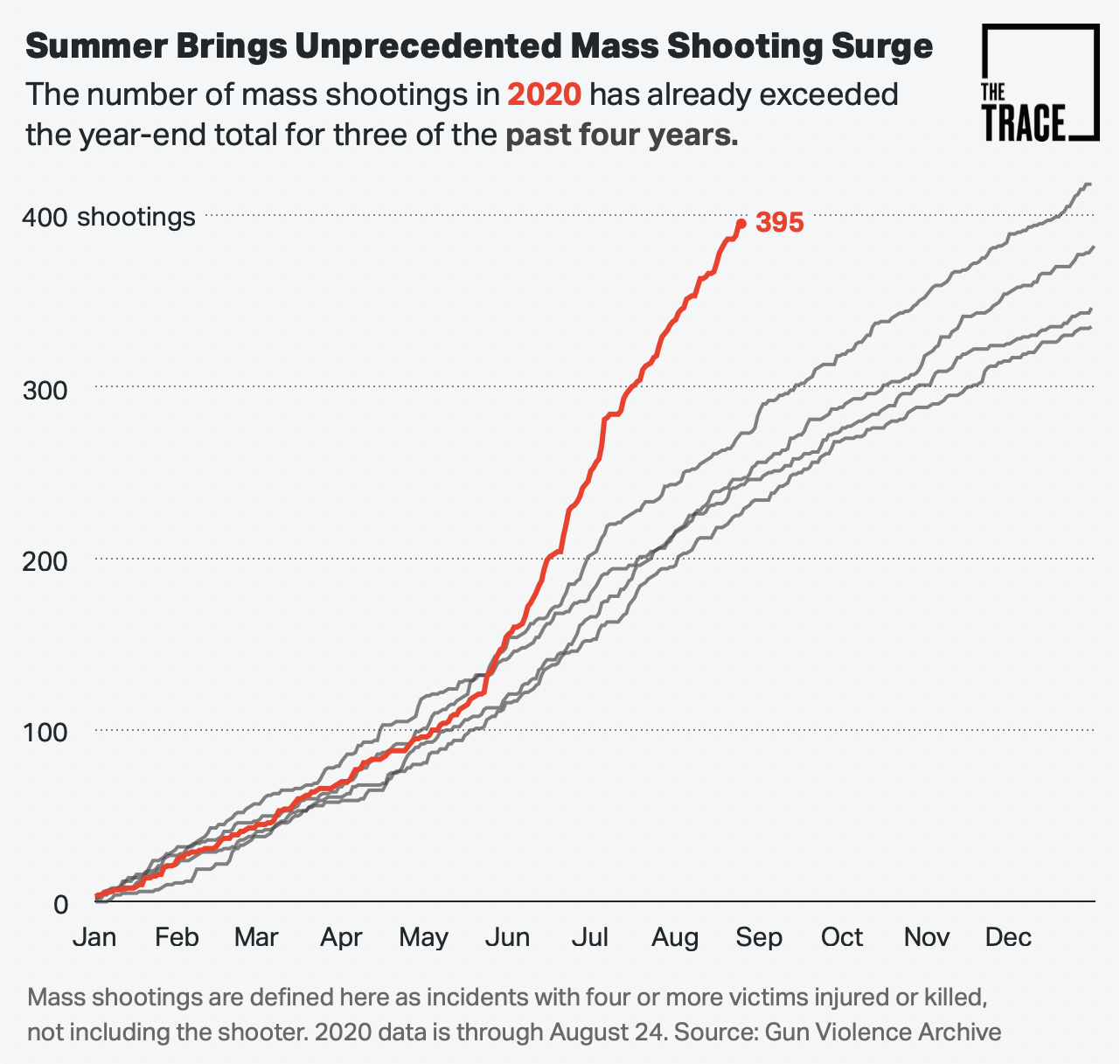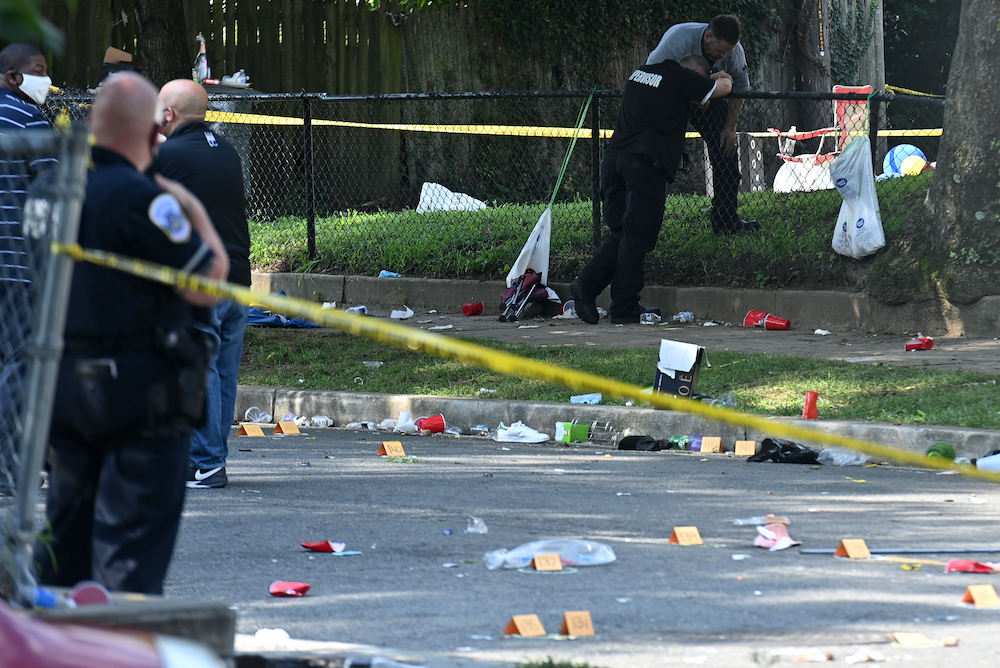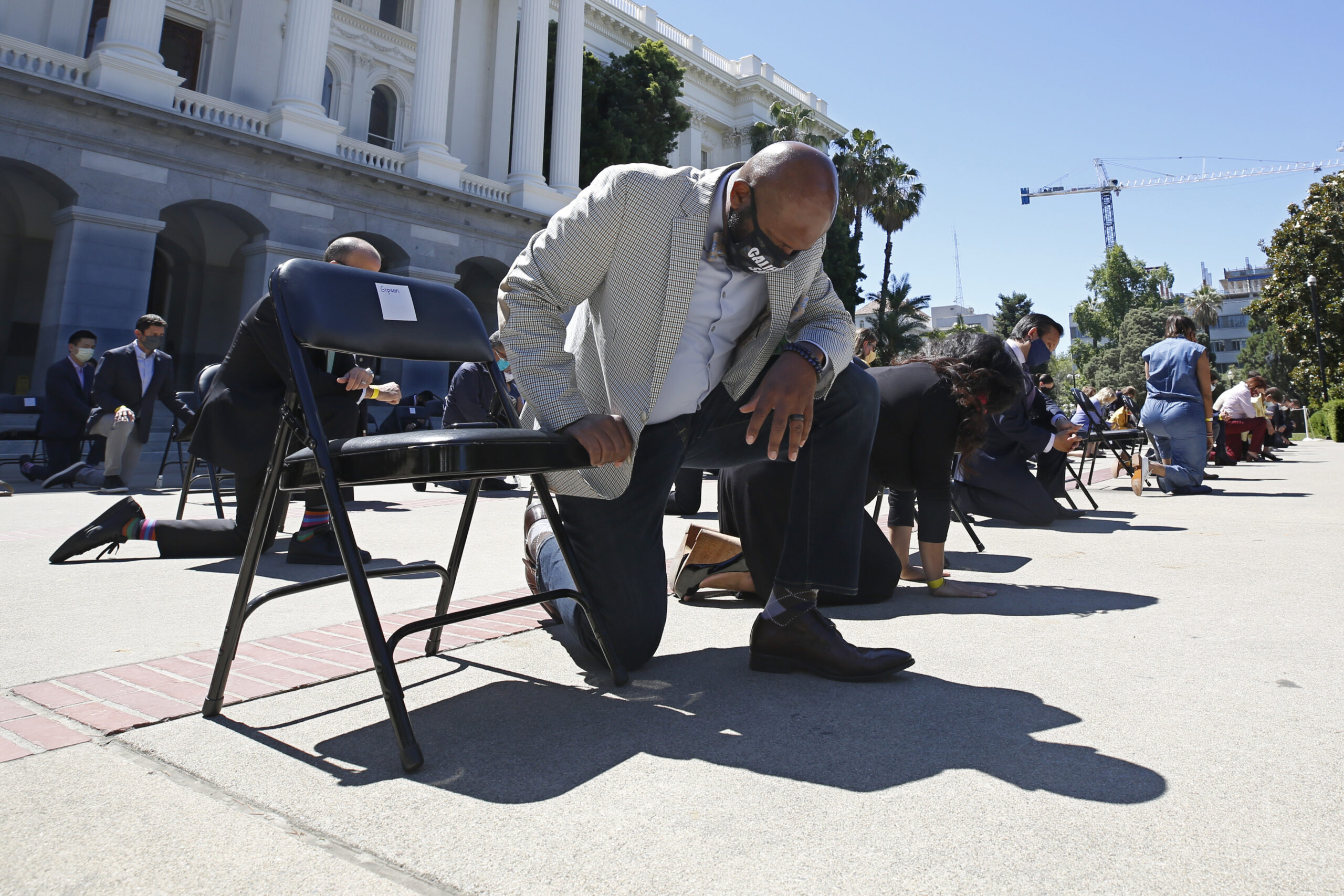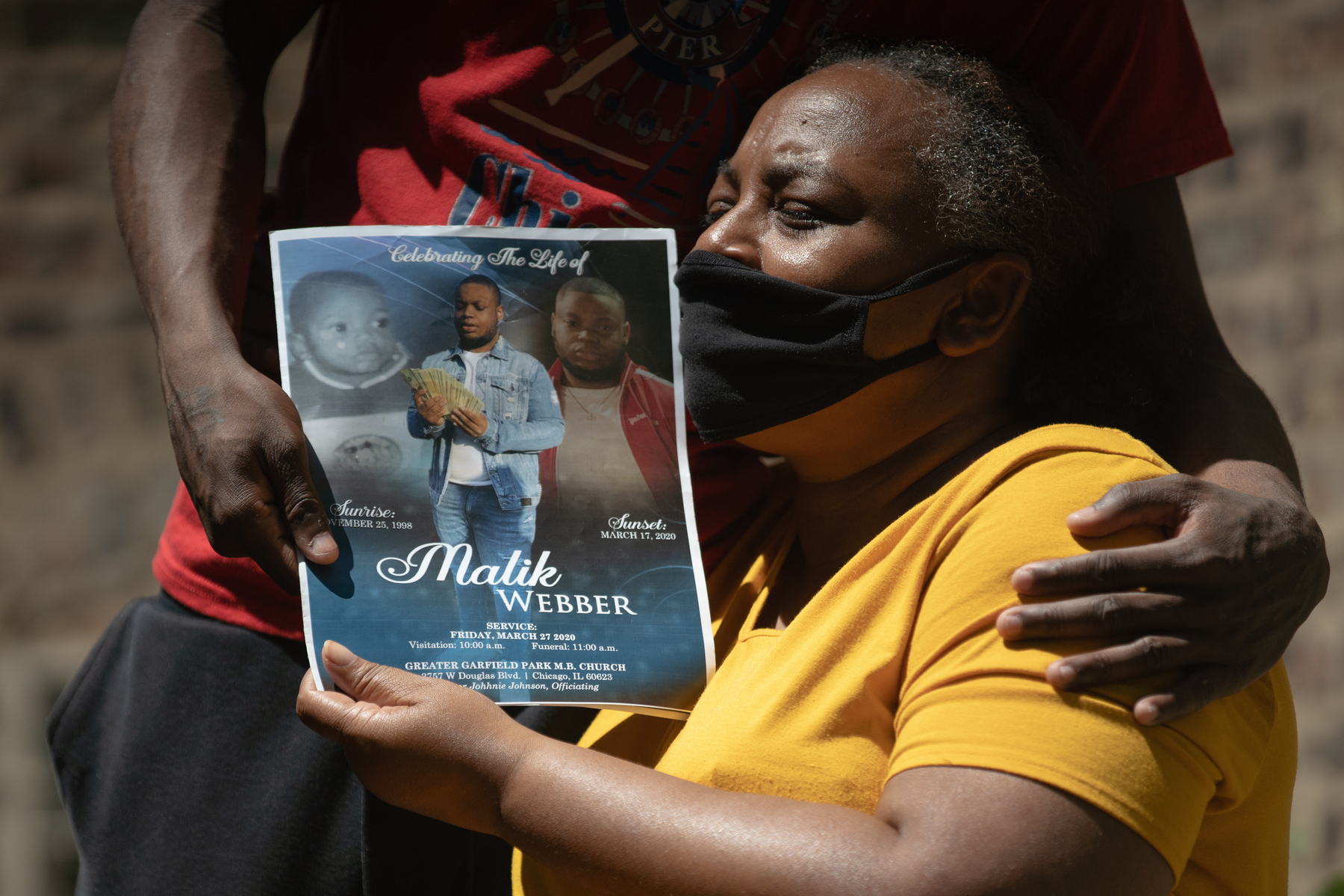This summer’s Rye Day celebration in Syracuse, New York, almost ended — as it had the past 14 years — without a hitch. The event, a public birthday party hosted by a local business owner and philanthropist, drew hundreds of residents to an outdoor performance space on June 20 on the city’s Near West Side, where they ate and drank, registered to vote, and escaped the various pressures of the pandemic.
But then a scuffle broke out. A Facebook Live stream shows a girl dancing, then noticing the commotion. “It’s a fight,” someone remarks, off camera. “Time to go.” The girl in the video agrees, playfully, but her concern escalates. The music stops. People scream. The crowd scatters, and the video turns into a whir of bodies and grass. Seconds later, more than a dozen gunshots ring out.
“It was chaos,” said Nitch Jones, a local youth pastor who was at the center of the crowd. “You had wounded individuals, wounded friends, family members, associates on the ground, all crying out for help. People experiencing someone who looks like they’re dead. People experiencing trauma for the first time.”
At the scene, Jones rushed to help the wounded. He spotted a body lying motionless on the asphalt. It was a boy who had been shot in the head. Jones helped calm the boy’s family until paramedics arrived, and wheeled his body to an ambulance. Photos from the aftermath show a woman standing in a haze of red light from the vehicle’s sirens. She’s barefoot, wearing a shirt with the words “Proud Mom” emblazoned on its back.
Her son, Chariel Osorio, had graduated from high school earlier that day. He was 17 years old. Less than a week later, he died of his injuries in a hospital bed.
Osario and the eight victims wounded in the Rye Day shooting are among more than 320 people killed and over 1,600 injured in mass shootings so far in 2020, according to the nonprofit Gun Violence Archive. What constitutes a “mass shooting” varies between government agencies and groups like Gun Violence Archive, which defines the incidents as any with four or more people wounded. Our analysis of Gun Violence Archive data found a total of 395 mass shootings as of August 24, an almost 45 percent increase over the same period last year. If the pace holds, this year’s total will be the highest tally since the organization began tracking shootings seven years ago.

The mass shootings have disproportionately occurred in predominantly Black neighborhoods. Nearly 50 percent of the shootings analyzed by The Trace took place in majority-Black census tracts, though less than 10 percent of census tracts nationally have majority Black populations. The pattern held in almost every city that has had more than five mass shootings in 2020. In Chicago, for example, 31 out of 36 shootings with four or more victims happened in majority-Black census tracts. In Detroit and Milwaukee, each of which saw five mass shootings, all of them occurred in majority-Black neighborhoods.
Every act of violence shocks the conscience, but the public setting of many mass shootings renders them acutely horrifying. People pursuing an activity presumed safe – going to church or school or the store, putting in a workday, enjoying a night out – suddenly confront a barrage of bullets. The ensuing media coverage stirs public mourning and donations. Activists and Democratic politicians cry for reform. But when a gunman in a dispute kills or injures multiple bystanders in a predominantly Black or Latinx community, the bloodshed is written off by some journalists, politicians, and onlookers as predictable, endemic to the neighborhood and therefore not worthy of the same sympathy.

With this year’s more frequent mass shootings part of a larger rise in homicides during the pandemic, President Donald Trump has used the violence to stoke fears among white voters and paint Democrats as soft on crime. His Justice Department is sending federal agents into cities under the aegis of Operation Legend, an initiative designed to produce quick increases in arrests and federal prosecutions, which evidence shows do not correlate to long-term reductions in violent crime and improvements in public safety. Democratic presidential nominee Joe Biden promises to increase restrictions on gun access but rejects proposals to reduce police funding and dramatically shift public dollars toward social services and grassroots interventions.
For Black gun violence prevention advocates, the responses to mass shootings in Black and Brown neighborhoods are dispiritingly familiar. “When these mass shootings happen in white communities, everybody has a response: they have policies, investments, thoughts and prayers,” said Amber Goodwin, the founding director of the Community Justice Action Fund. “When Black people are shot and killed, it’s a lack of response. Or if there is a response, it’s a divestment. It’s carceral.”
On August 14, activists, family members, pastors, and friends gathered at an intersection on a leafy residential street in Southeast Washington, D.C., to mourn the death of Chris “Pappi” Brown. Five days before, Brown had been killed at an annual block party after more than 100 shots were fired into a crowd of more than 300. The shooting left 21 injured and Brown dead. He was 17.
Like other large cities during the pandemic, Washington has struggled to contain a troubling rise in homicides, even as other crime has declined. So far, the city has recorded 133 homicides, and if the current pace holds, that number may pass 200 for the first time in more than a decade. Encompassed within the surge is an uptick in mass shootings. More than seven shootings have left four or more injured in the district in the past five months alone.
The increase worries those who study the effects of mass violence on public life, like Yale sociologist Vida Bajc. Since the coronavirus hit the United States, Bajc has been concerned that people in cities — who have sacrificed privacy and home-size for the tight-knit social fabric of urban life — have had to endure a profound alienation as public space grows more dangerous to inhabit. Mass shootings, she said, only compound this sense of isolation. “Public spaces are extensions of our homes,” she said. “So this is an invasion on two fronts: You don’t know who carries a gun, who’s going to blow up and get angry and start shooting; and you don’t know who has the virus. So what I see is people closing in on themselves.”

Like the Rye Day party in Syracuse, the block party at which Brown was killed was meant to provide some relief during a COVID-warped summer. “You had hundreds of people from across the city who came to the event looking for fellowship and bonding,” said Tia Bell, founder of the Trigger Project, a gun violence reduction group based in Washington. What the organizers hadn’t accounted for, though, was the way that the disruptions people sought to escape would also fuel new conflicts, she said.
“All of the root causes that fuel the cycle of gun violence are intensified right now,” said Greg Jackson, advocacy director at Community Justice Action Fund, which is based in Washington. “There aren’t fewer police officers out there, but there are fewer jobs and fewer educational opportunities.”
The same turmoil is fueling violence outside of major cities. In states that ended lockdown restrictions early into the virus’s spread, people in rural and suburban communities have been eager to reclaim their pre-pandemic lives, only to have their communities rattled by acts of mass violence. Many of the mass shootings documented by the Gun Violence Archive occurred in such places, striking public venues just beginning to attract patrons after closing during coronavirus shutdowns.
Royta Giles Jr.’s parents were shopping for a Fourth of July outfit for him at the Riverchase Galleria in Hoover, Alabama, the state’s largest mall, when three men opened fire at one another inside. Royta, 8 years old, was caught in the crossfire. Bullets wounded three other bystanders.
“We heard the gunshots and I grabbed them, and we hit the ground,” Royta’s mother, Jesslyn Layfield, told AL.com. “He was the only one who didn’t get up.”
Royta’s death led to an outpouring of community support — at a well-attended vigil outside the mall, his mother spoke through tears about the strangers who showed up to help her through her grieving. But like the Rye Day shooting in Syracuse and the block party shooting in D.C. after it, the violence prompted little national attention.
Jason Silva, a professor of criminal justice at William Paterson University who studies media coverage of mass shootings, has noted a distinction between “mass public shootings” — the incidents that have come to define mass shootings in the American consciousness, where the shooter targets a specific public space for a rampage — and mass shootings that grow out of violence between individuals or groups, but wind up claiming bystanders among those shot. “The mass public shootings are what get more coverage, traditionally,” he said, irrespective of the race of perpetrators or victims.
Silva has advocated cautiously for increasing media coverage of conflict-related mass shootings as a means of generating public support for necessary legislative changes. “If we want to address the gun violence problem at large” — which overwhelmingly comprises conflict related shootings like the one at the Galleria — “then we should 100 percent be showing them the same media attention,” he said. “But we should keep in mind the harm caused during the tough-on-crime era of the ‘80s and ‘90s, which was driven in part by exhaustive media coverage.”
While most Americans went unaware, the shootout at the Galleria traumatized those who witnessed it. “My chest was shaking so bad, and my hands were shaking, and I was trying to keep myself from panicking,” said Rebecca Skelton, who was mid-shift at a Build-a-Bear Workshop nearby when the shots rang out. “But that’s what you think is: you know, is it over? How many bodies are there outside my door? What is going on out there, and is it going to come in here?”
Skelton turned in her letter of resignation two days later. Several coworkers did the same. “I have PTSD from working at a toy store,” she said.
“Mass shootings in Black and Brown communities may be new to you all — not new to us,” said DeVone Boggan, the executive director of the Bay Area-based violence prevention group Advance Peace. “And it’s never been considered a mass shooting. Not until white folks started dying did we start hearing about this phenomena called mass shootings. But drive-by shootings — i.e., ‘mass shootings’ — have been happening forever, COVID or not.”
The pandemic has exacerbated violence in underserved areas by introducing unemployment, hampering access to mental health care and other social services, and keeping everyone home, fueling conflict within families and communities — and making rivals easier to track down, Boggan said.
“Being in a dysfunctional environment with multiple people who are all going through the same thing and respond in volatile ways creates a combustion that can produce some of the things that we are seeing in some of these neighborhoods,” he said.
To Boggan and his fellow violence interrupters, it’s important to call out what underlies the formula for which mass shootings generate public attention and which are overlooked. “It’s part of systemic racism,” said Fernando Rejón, executive director of Urban Peace Institute, an initiative in Los Angeles that provides training for violence intervention workers. “The automatic assumption is, ‘it’s probably gang-related,’ ‘they’re all involved in something illegal.’ If it happened at a bar or a nightclub, where it’s not ‘supposed’ to happen, then it makes national news.
“Systemic racism,” Rejón added, “is really about power: the power to determine who’s valued and who is not.”
On a Sunday afternoon in April, about two weeks after California issued its first stay-at-home orders, Devon Gipson and his fiancé, Jennifer Salazar, were walking to a store in the residential Gramercy Park neighborhood of Los Angeles when someone drove by and opened fire. A bullet hit Gary Patrick Moody in a nearby car, killing him. Another bullet wounded a 49-year-old man in the arm, and another bullet hit Salazar in the leg. A fourth round struck Gipson in the back, fracturing his rib and puncturing his lung before exiting his body.
Gipson, a father and full-time employee at the toy company Mattel, underwent surgery and survived the mass shooting, which was one of at least three in the city since March. Local media extensively covered Gipson’s shooting: his father is California Assemblymember Mike Gipson. A Democrat, Mike Gipson dealt with the issue before his son’s shooting, introducing a bill last year that would require the registration of home-assembled ghost guns. He’d held anti-violence rallies just blocks from where his son was shot.
“As a father, the news of my son being shot was devastating to myself and my family,” the lawmaker told reporters after the shooting. “As a legislator, I know that too often many families experience similar scenarios on a regular basis. This must stop.”
Statewide, California has had 20 mass shootings during the COVID-19 crisis. In June, two women, 37 and 63, were killed and three others were wounded in a drive-by shooting at a child’s birthday party in the Northern California city of Vallejo. The next day, a local musician was killed and four others were wounded in a targeted shooting in Sacramento on June 10. Two weeks later, Two girls, 11 and 12, were killed and three adults were injured in a drive-by shooting at a birthday party in Delano.
In Syracuse, the weeks following the Rye Day party saw a rash of shootings, some retaliatory, some unrelated, according to local activists. Through August, the city saw 22 homicides, more than it did in all of 2019 and on track for an all-time record.
The gun violence has been so unrelenting that the Rye Day shooting hardly felt like an anomaly to some who live nearby. “People who were shocked were people who were not from Syracuse,” said Dr. Najah Salaam, chief operating officer of the Street Addiction Institute, a local violence prevention nonprofit.
Reverend YL Wright, Sr., a minister at Tucker Missionary Baptist Church on Syracuse’s South Side, agreed, adding that after living in the city for nearly five decades, he’s now wary of deviating from his usual routine, lest he wind up in a barrage of gunfire. “I don’t go anywhere where there’s crowds at.”
A 2015 analysis of census data determined that Syracuse had the highest rate of extreme poverty among Black and Latinx people out of the nation’s 100 largest metropolitan areas. The statistic was quoted often by activists and community residents interviewed for this story, who held it up as evidence of a problem they’ve recognized since they were young — a problem of scarcity that they say drives gun violence.

Salaam and Wright both pointed to a lack of jobs and afterschool programs, homelessness, an underfunded school district, and a debilitating segregation enforced by Interstate 81, which slices the city in half along its north-south axis, as parts of a system rigged against their communities.
To local activists, the scarcity of resources and the failure of mass shootings like the one at Rye Day to garner significant national concern are connected: They both represent neglect of the problems plaguing Black communities. Salaam offered an example to prove this point.
“In Fayetteville” — a village just outside of Syracuse — “there was a big-to do about swan eggs that had been crushed,” she said. “They vandalized these swan eggs and the community was absolutely outraged. People set up cameras and donated money and citizens took turns to stay overnight just to protect the swan eggs.
“Then you have a situation like what you’re describing here in Syracuse where nine people are shot and one child was murdered on the night of his graduation, and you see a couple of media news clips about it. Nobody marched. There was no public outrage.”
The takeaway, she said, was clear: “Nobody cares about us.”


